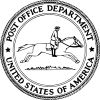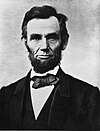William Dennison Jr.
William Dennison | |
|---|---|
Governor of Ohio | |
| In office January 9, 1860 – January 13, 1862 | |
| Lieutenant | Robert C. Kirk |
| Preceded by | Salmon P. Chase |
| Succeeded by | David Tod |
| Personal details | |
| Born | November 23, 1815 Cincinnati, Ohio, U.S. |
| Died | June 15, 1882 (aged 66) Columbus, Ohio, U.S. |
| Resting place | Green Lawn Cemetery |
| Political party | Whig Republican |
| Spouse | Anne Neil |
| Education | Miami University, Oxford (BA) |
| Signature | |
William Dennison Jr. (November 23, 1815 – June 15, 1882) was a
.Early life and career
Born in
In 1840, he married Anne Eliza Neil, the daughter of the wealthy Columbus businessman William Neil, whose farm later became the campus of Ohio State University. Together, William and Anne Dennison had seven children. The eldest of them was a son, William Neil Dennison, who later won distinction in the Civil War while serving in the U.S. Horse Artillery Brigade.
William Dennison Jr. was one of the first major Ohio politicians to leave the dying Whig Party for the new Republican Party. He rose quickly through the party ranks due to his
Civil War
With turmoil growing in the neighboring Virginia and many states in the south seceding, Dennison, like the governors of most other states, set immediately to recruiting troops and mustering militia to defend his state. When Lincoln issued the proclamation for 75,000 in militia, Dennison was requested from Washington by wire to raise thirteen regiments of militia, but he wired back that he "could hardly stop before twenty" due to the large turnout of recruits and his concern that secessionist troops could attack Ohio from the direction of Northwest Virginia. Dennison, unfamiliar with military affairs, was like the governors of Pennsylvania, New York, and Michigan searching for qualified military men to command their growing state militia, and none was more sought after than
Dennison and his cabinet observed the ominous developments in north-western Virginia throughout mid-April 1861 to May of that year, where northwestern Virginians were convening to secede from eastern Virginia, and pro-union sentiment was common and widespread. Richmond at the same time was also vying to send troops to the area to suppress these secessionist activities. Many Northwestern Virginians wrote to Dennison requesting him to send troops from Ohio to the area to defend from possible reprisals from east Virginia, the editor of the Wheeling Intelligencer wrote a letter to Dennison encouraging him to occupy NW Virginia, writing that "Secession is creeping up", and that "Union men in Northwestern Virginia will shortly be slaughtered".
However, errors by the Governor and his subordinates led the state's alliance of Republicans and
Dennison accepted this turn of events with good grace, capably advised his successor, and provided valuable services in helping recruit black troops for Ohio units. He served as Chairman of the Republican National Convention in 1864. He was appointed U.S. Postmaster General by President Abraham Lincoln, and served from 1864 to 1866, leaving the Cabinet after he decided he could no longer support the policies of President Andrew Johnson.
Postbellum career and memorialization
After the war, Dennison served on the
Of Dennison's single term in the opening stages of the Civil War, historian John S. Stilt wrote, "His wisdom and foresight were appreciated by few and condemned by many.... It is doubtful whether any of his predecessors could have met the issues any more successfully."
Camp #1 of the Department of Ohio of the Sons of Union Veterans of the Civil War is named for Governor William Dennison. It was chartered August 1, 1882, shortly after Dennison's June 15, 1882 death at age 66.
The William Dennison school in Washington, DC, named in his honor, was opened in 1885 on S Street between 13th and 14th Streets, NW. It closed sometime after 1947 and was razed prior to 1985.
Dennison is honored with a full-size bronze depiction inside the Cuyahoga County Soldiers' and Sailors' Monument in Cleveland, Ohio for his service as governor during the Civil War.[3]
Camp Dennison is a census-designated place (CDP) just outside Indian Hill in southern Symmes Township, Hamilton County, Ohio, United States. It has a post office with the ZIP code 45111.[3] The population was 375 at the 2010 census. The community was settled in 1796 by German immigrants.[5] During the American Civil War, Camp Dennison served as a military recruiting and training post for the United States Army (see Camp Dennison). It is named for William Dennison, the 24th Governor of Ohio and U.S. Postmaster General under President Abraham Lincoln.
References
- ^ a b "DCPL: MLK: Washingtoniana Division: FAQs: DC Commissioners". Archived from the original on September 27, 2007. Retrieved 6 October 2015.
{{cite web}}: CS1 maint: unfit URL (link) - ^ ISBN 0895264528.
- ISBN 978-0-578-48036-7.)
{{cite book}}: CS1 maint: location missing publisher (link
- Harper, Robert S., Ohio Handbook of the Civil War. Columbus, Ohio: The Ohio Historical Society, 1961.
- Ohio in the War: Her Statesmen, Her Generals, and Soldiers. 2 vol. Cincinnati: Moore, Wilstach, & Baldwin, 1868.
- Dennison Camp of the SUCV





